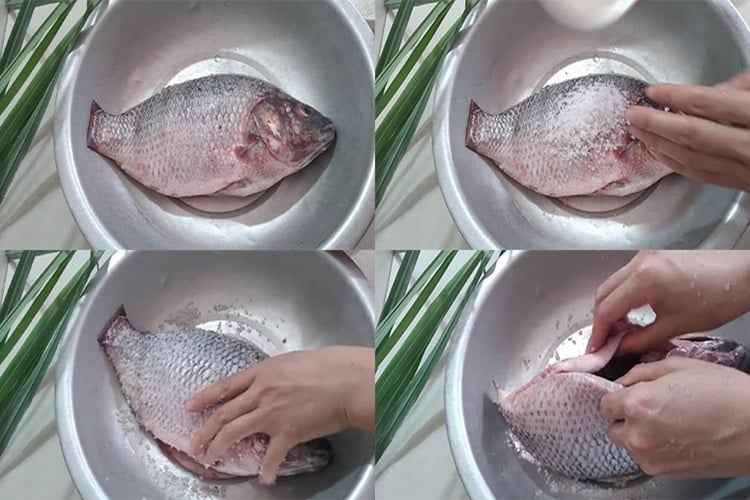Crispy fried tilapia is a rustic and familiar dish on the dining tables of many Vietnamese families. Fried tilapia with its golden, crispy skin and aromatic fragrance is a favorite among many.

1. Should the scales be kept on or scraped off when frying tilapia?
The answer depends on personal preference and dining purpose. However, if you aim for a crisp texture without breaking the fish, it is best to keep the scales intact.
Why keep the scales when frying tilapia?
-
The scales act as a protective barrier, preventing the fish meat from burning or drying out.
-
When fried correctly, the scales puff up and become deliciously crispy, offering a unique texture and taste comparable to the crispy fish served in restaurants.
-
It minimizes sticking to the pan, especially when using a cast iron skillet or an aged non-stick pan.
On the other hand, if diners prefer a softer texture without the crunch of scales or desire a more thoroughly seasoned fish, the scales can be scraped off before frying. However, this requires extra care during frying to prevent the fish from falling apart.
2. Tips for frying tilapia to achieve a golden crisp on both sides
Whether you choose to keep the scales on or not, the following tips are essential for a perfectly fried tilapia:
Step 1: Tilapia Preparation
-
Select fresh and medium-sized tilapia from the local pond or market.
-
Clean the insides and remove any gills or fins. Rinse thoroughly with a mixture of salt and vinegar diluted in water or rice water to eliminate any slimy residue.
-
If keeping the scales on, use a knife to gently scrape off any remaining slime to prevent a fishy taste during frying.
Step 2: Marination (if scales are removed)
-
Marinate the fish with a mixture of salt, pepper, crushed red onions, and turmeric for a beautiful golden color.
-
If the scales are kept on, there is no need to marinate the fish directly, as the seasonings will not penetrate the scales.
Step 3: Preventing the fish from sticking to the pan
-
Ensure the fish is thoroughly dried before frying. Moisture can cause the fish to stick to the pan.
-
Heat the pan before adding oil, then pour in enough oil to just barely submerge the lower half of the fish.
-
Test the oil temperature by inserting a wooden chopstick—if you see tiny bubbles forming around the chopstick, the oil is ready.
-
Place the fish in the pan and fry over medium heat. Do not flip the fish immediately to avoid breaking it. Wait until one side is golden and crisp before turning it over.

Step 4: Secret to crispy scales
-
When frying with the scales on, gently press down on the fish with a spatula for 30 seconds to 1 minute to ensure even expansion of the scales.
-
For extra crispness, lightly dust the scales with dry flour before frying.
3. Tips to enhance the flavor
-
After frying, drizzle the fish with a savory mixture of scallion oil or a sweet and sour fish sauce to elevate the dish.
-
Serve with fresh herbs, cucumbers, and steamed rice for a well-balanced meal that tempers the richness of the dish.
If you prefer your tilapia with a crisp texture and minimal breakage, keep the scales on. Conversely, if you favor a more seasoned and flavorful fish, scrape off the scales but exercise caution during frying to prevent breakage. With this knowledge, frying tilapia will become your secret culinary weapon, impressing your family and leaving them craving for more!































